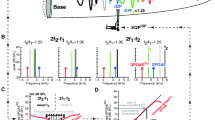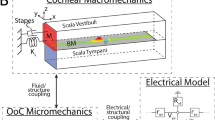Abstract
Normal hearing is associated with cochlear nonlinearity. When two tones (f1 and f2) are presented, the intracochlear response contains additional components that can be recorded from the ear canal as distortion product otoacoustic emissions (DPOAEs). Although the most prominent intermodulation distortion component is at 2f1-f2, other cubic distortion products are also generated. Because these measurements are noninvasive, they are used in humans and in animal models to detect hearing loss. This study evaluated how loss of sensitivity affects DPOAEs with frequencies above and below the stimulating primaries, i.e., for upper sideband (USB) components like 2f2-f1 and for lower sideband (LSB) components like 2f1-f2. DPOAEs were recorded in several mouse mutants with varying degrees of hearing loss associated with structural changes to the tectorial membrane (TM), or with loss of outer hair cell (OHC) somatic electromotility due to lack of prestin or to the expression of a non-functional prestin. In mice with changes in sensitivity, magnitude reductions were observed for 2f1-f2 relative to controls with mice lacking prestin showing the greatest changes. In contrast, 2f2-f1 was minimally affected by reductions in cochlear gain due to changes in the TM or by the loss of OHC somatic electromotility. In addition, TM mutants with spontaneous otoacoustic emissions (SOAEs) generated larger responses than controls at 2f2-f1 when its frequency was similar to that for the SOAEs. Although cochlear pathologies appear to affect USB and LSB DPOAEs in different ways, both 2f1-f2 and 2f2-f1 reflect nonlinearities associated with the transducer channels. However, in mice, the component at 2f2-f1 does not appear to receive enhancement due to prestin’s motor action.








Similar content being viewed by others
Data Availability
Data in this manuscript can be made available to interested parties by contacting the author.
References
Kim DO (1980) Cochlear mechanics: implications of electrophysiological and acoustical observations. Hear Res 2(3–4):297–317. PubMed PMID: 7410234
Siegel J (2008) Otoacoustic emissions. In: Basbaum AI, Kaneko A, Shepherd G, Westheimer G (eds) The Senses: A Comprehensive Reference. Academic Press, San Diego, pp 237–262
Lonsbury-Martin BL, Martin GK (2008) Otoacoustic emissions: Basic studies in mammalian models. In: Manley G, Fay R, Popper A (eds) Active Processes and Otoacoustic Emissions. Springer, New York NY, pp 261–303
Zheng J, Shen W, He DZ, Long KB, Madison LD, Dallos P (2000) Prestin is the motor protein of cochlear outer hair cells. Nature 405(6783):149–155. PubMed PMID: 10821263
Dallos P, Wu X, Cheatham MA, Gao J, Zheng J, Anderson CT, Jia S, Wang X, W.H.Y. C, Sengupta S, He DZZ, Zuo J (2008) Prestin-based outer hair cell motility is necessary for mammalian cochlear amplification. Neuron 58:1–7
Liberman MC, Gao J, He DZ, Wu X, Jia S, Zuo J (2022) Prestin is required for electromotility of the outer hair cell and for the cochlear amplifier. Nature 419(6904):300–304. Epub 2002/09/20. https://doi.org/10.1038/nature01059. PubMed PMID: 12239568
Cheatham MA, Huynh KH, Gao J, Zuo J, Dallos P (2004) Cochlear function in Prestin knockout mice. J Physiol 560(Pt 3):821–830. PubMed PMID: 15319415
Dallos P, Wang CY (1974) Bioelectric correlates of kanamycin intoxication. Audiology 13(4):277–289. PubMed PMID: 4606272
Ryan A, Dallos P (1975) Effect of absence of cochlear outer hair cells on behavioural auditory threshold. Nature 253(5486):44–46. PubMed PMID: 1110747
Brown AM, McDowell B, Forge A (1989) Acoustic distortion products can be used to monitor the effects of chronic gentamicin treatment. Hear Res 42:143–156
Legan PK, Lukashkina VA, Goodyear RJ, Kossi M, Russell IJ, Richardson GP (2000) A targeted deletion in alpha-tectorin reveals that the tectorial membrane is required for the gain and timing of cochlear feedback. Neuron 28(1):273–285. PubMed PMID: 11087000
Liberman MC, Zuo J, Guinan JJ Jr (2004) Otoacoustic emissions without somatic motility: can stereocilia mechanics drive the mammalian cochlea? J Acoust Soc Am 116(3):1649–1655. PubMed PMID: 15478431
Jaramillo F, Markin VS, Hudspeth AJ (1993) Auditory illusions and the single hair cell. Nature 364(6437):527–529. PubMed PMID: 8336792
Cheatham MA (2021) Spontaneous otoacoustic emissions are biomakers for mice with tectorial membrane defects. Hear Res 409:108314
Richardson GP, Lukashkin AN, Russell IJ (2008) The tectorial membrane: one slice of a complex cochlear sandwich. Curr Opin Otolaryngo 16(5):458–464. https://doi.org/10.1097/MOO.0b013e32830e20c4.PubMedPMID:WOS:000262716300011
Cheatham MA, Goodyear RJ, Homma K, Legan PK, Korchagina J, Naskar S, Siegel JH, Dallos P, Zheng J, Richardson GP (2014) Loss of the tectorial membrane protein CEACAM16 enhances spontaneous, stimulus-frequency, and transiently evoked otoacoustic emissions. J Neurosci 34(31):10325–10338. https://doi.org/10.1523/JNEUROSCI.1256-14.2014. PubMedPMID: 25080593; PMCID: PMC4115139
Cheatham MA, Zhou Y, Goodyear RJ, Dallos P, Richardson GP (2018) Spontaneous Otoacoustic Emissions in Tecta(Y1870C/+) Mice Reflect Changes in Cochlear Amplification and How It Is Controlled by the Tectorial Membrane. eNeuro 5(6):314–318. Epub 2019/01/11. https://doi.org/10.1523/ENEURO.0314-18.2018. PubMed PMID: 30627650; PMCID: PMC6325554
Legan PK, Lukashkina VA, Goodyear RJ, Lukashkin AN, Verhoeven K, Van Camp G, Russell IJ, Richardson GP (2005) A deafness mutation isolates a second role for the tectorial membrane in hearing. Nat Neurosci 8(8):1035–1042. https://doi.org/10.1038/nn1496. PubMed PMID: 15995703
Russell IJ, Legan PK, Lukashkina VA, Lukashkin AN, Goodyear RJ, Richardson GP (2007) Sharpened cochlear tuning in a mouse with a genetically modified tectorial membrane. Nat Neurosci 10(2):215–223. Epub 2007/01/16. https://doi.org/10.1038/nn1828. PubMed PMID: 17220887; PMCID: PMC3388746
Neely SR, Stevenson R (1992) Tech Memo No. 1. Omaha NE: Boys Town National Research Hospital
Neely S, Liu Z (1994) EMAV: otoacoustic emission averager. Boys Town National Research Hospital, Omaha NE
Goodyear RJ, Cheatham MA, Naskar S, Zhou Y, Osgood RT, Zheng J, Richardson GP (2019) Accelerated age-related degradtion of the tectorial membrane in the Ceacam16 βgal/βgal null mutant mouse, a model for late-onset human hereditary deafenss DFNB113. Front Mol Neurosci 12:147
Cheatham MA, Edge RM, Homma K, Leserman EL, Dallos P, Zheng J (2015) Prestin-dependence of outer hair cell survival and partial rescue of outer hair cell loss in Prestin V499G/Y501H knockin mice. PLoS ONE e0145428
Wilson H, Lutman M (2006) Mechanisms of generation of the 2f2-f1 distortion product otoacoustic emission in humans. J Acoust Soc Am 120
Botti T, Sisto R, Sanjust F, Moleti A, D'Amato L (2016) Distortion product otoacoustic emission generation mechanisms and their dependence on stimulus level and primary frequency ratio. J Acoustic Soc Am 139(2):658–673. PubMed PMID: Medline: 26936550
Zurek P, Clarke W (1981) Narrow-band acoustic signals emitted by chinchilla ears after noise exposure. J Acoust Soc Am 70:446–480
Cheatham MA, Naik K, Siegel JH, Dallos P (2011) Intermodulation DPOAEs in mice below and above the eliciting primaries. Abs Assoc Res Otolaryngol 33
Kemp D (2002) Otoacoustic emissions, their origin in cochlear function, and use. Br Med Bull 63:223–241
Jia S, He DZZ (2005) Motility-associated hair-bundle motion in mammalian outer hair cells. Nat Neurosci 8:1028–1034
Takahashi S, Santos-Sacchi J (1999) Distortion component analysis of outer hair cell motility-related gating charge. J Membr Biol 169(3):199–207. PubMed PMID: 10354466
Santos-Sacchi J (1993) Harmonics of outer hair cell motility. Biophys J 65(5):2217–2227. PubMed PMID: 8298045
Kim DO, Molnar CE, Matthews JW (1980) Cochlear mechanics: nonlinear behavior in two-tone responses as reflected in cochlear-nerve-fiber responses and in ear-canal sound pressure. J Acoust Soc Am 67(5):1704–1721. PubMed PMID: 7372925
Hall JL (1980) Cochlear models: Evidence in suppression of mechanical nonlinearities and a second filter (A review). Hear Res 2:455–464
Ren T (2004) Reverse propagation of sound in the gerbil cochlea. Nat Neurosci 7:333–334
Brown A, Kemp D (1985) Intermodulation distortion in the cochlea: could basal vibration be the major cause of round window CM distortion? Hear Res 19:191–198
Kemp D (1986) Otoacoustic emissions, travelling waves and cochlear mechanisms. Hear Res 22:95–104
Shera CA, Guinan JJ Jr (1999) Evoked otoacoustic emissions arise by two fundamentally different mechanisms: a taxonomy for mammalian OAEs. J Acoust Soc Am 105(2 Pt 1):782–798. PubMed PMID: 9972564
Knight RD, Kemp DT (2000) Indications of different distortion product otoacoustic emission mechnaisms from a detailed f1, f2 area study. J Acoust Soc Am 107:457–473
Dong W, Olson E (2008) Supporting evidence for reverse cochlear traveling waves. J Acoust Soc Am 123:222–240
Wen H, Bowling T, Meaud J (2018) Investigation of the 2f1-f2 and 2f2-f1 distortion product otoacoustic emissions using a computational model of the gerbil ear. Hear Res 365:127–140
Martin GK, Stagner B, Lonsbury-Martin B (2010) Evidence for basal distortion-product otoacoustic emission compnents. J Acoust Soc Am 127:2955–2972
Martin GK, Lonsbury-Martin BL, Probst R, Scheinin S, Coats A (1987) Acoustic distortion products in rabbit ear canal. II Sites of origin revealed by suppression contours and pure-tone exposures. Hear Res 28
Knight RD, Kemp DT (2001) Wave and place fixed DPOAE maps of the human ear. J Acoust Soc Am 109:1513–1525
Martin G, Stagner B, Dong W, Lonsbury-Martin B (2016) Comparing distortion product otoacoustic emissions to intracochlear distortion products inferred from a noninvasive assay. J Assoc Res Otolaryngol 17:271–287
Withnell RH, Shaffer LA, Talmadge CL (2003) Generation of DPOAEs in the guinea pig. Hear Res 178(1–2):106–117. Epub 2003/04/10. https://doi.org/10.1016/s0378-5955(03)00064-9. PubMed PMID: 12684183
Dong W, Olson ES (2010) Local cochlear damage reduces local nonlinerity and decreases generator-type cochlear emissions while increasing reflector-type emissions. J Acoust Soc Am 1422–1431
Talmadge CL, Tubis A, Long GR, Tong C (2000) Modeling the combined effects of basilar membrane nonlinearity and roughness on stimulus frequency otoacoustic emission fine structure. J Acoust Soc Am 108(6):2911–2932. Epub 2001/01/06. https://doi.org/10.1121/1.1321012. PubMed PMID: 11144584
Dhar S, Long GR, Talmadge CL, Tubis A (2005) The effect of stimulus-frequency ratio on distortion product otoacoustic emission components. J Acoust Soc Am 117:3766–3776
Bowling T, Wen H, Meenderrnk SWF, Dong W, Meaud J (2021) Intracochlear distortion products are broadly generated by outer hair cells but their contributions to otoacoustic emissions are spatially restricted. Sci Rep 11:13651
Durante AS, Akhtar US, Dhar S (2022) Distortion product otoacoustic emission component behavior as a function of primary frequency ratio and primary levels. Ear Hear 43:1824–1835
Siegel JH, Cerka AJ, Recio-Spinoso A, van Dijk P, Ruggero MA (2005) Delays of stimulus-frequency otoacoustic emissions and cochlear vibrations contradict the theory of cohlerent refelction filtering. J Acoust Soc Am 118:2434–2443
Charaziak KK, Siegel JH (2015) Tuning of SFOAEs Evoked by Low-Frequency Tones Is Not Compatible with Localized Emission Generation. J Assoc Res Otolaryngol 16(3):317–329. Epub 2015/03/31. https://doi.org/10.1007/s10162-015-0513-0. PubMed PMID: 25813430; PMCID: PMC4417092
Charaziak KK, Siegel JH, editors (2015) Low-frequency tone-pip-evoked otoacoustic emissions orginate over a broad cochlear region in chinchillas. Mechanics of Hearing: Proteins to Perception; American Institute of Pysics, Melville NY
Ruggero MA (1992) Responses to sound of the basilar membrane of the mammalian cochlea. Curr Opin Neurobiol 2(4):449–456. PubMed PMID: 1525542
Whitfield IC, Ross HF (1965) Cochlear-microphonic and summating potentials and the outputs of individual hair-cell generators. J Acoust Soc Am 38:126–131
Dewey JB (2022) Cubic and quadratic distortion products in vibrations of the mouse cochlear apex. JASA Express Lett 2(11):114402. Epub 2022/12/02. https://doi.org/10.1121/10.0015244. PubMed PMID: 36456371; PMCID: PMC9704500
Wegel R, Lane C (1924) The auditory masking of one pure tone by another and its probable relation to the dynamics of the inner ear. Phys Rev 23:266–285
Egan J, Hake H (1950) On the masking pattern of a simple auditory stimulus. J Acoust Soc Am 22:622–630
Acknowledgements
Supported by The Knowles Hearing Center and NIDCD grant DC000089. Some of the results were collected by Y. Zhou, K. Naik, T. Kim, and A. Ahmad. The expertise of J. H. Siegel has been invaluable and is greatly appreciated. It should also be understood that the ANOVA statistical analysis was performed by K. Homma. Wise counsel from the reviewers and the Associate Editor also improved this effort.
Author information
Authors and Affiliations
Corresponding author
Ethics declarations
Conflict of Interest
The author declares that there are no conflicts of interest.
Additional information
Publisher's Note
Springer Nature remains neutral with regard to jurisdictional claims in published maps and institutional affiliations.
Rights and permissions
Springer Nature or its licensor (e.g. a society or other partner) holds exclusive rights to this article under a publishing agreement with the author(s) or other rightsholder(s); author self-archiving of the accepted manuscript version of this article is solely governed by the terms of such publishing agreement and applicable law.
About this article
Cite this article
Cheatham, M.A. Distortion Product Otoacoustic Emissions in Mice Above and Below the Eliciting Primaries. JARO 24, 413–428 (2023). https://doi.org/10.1007/s10162-023-00903-4
Received:
Accepted:
Published:
Issue Date:
DOI: https://doi.org/10.1007/s10162-023-00903-4




